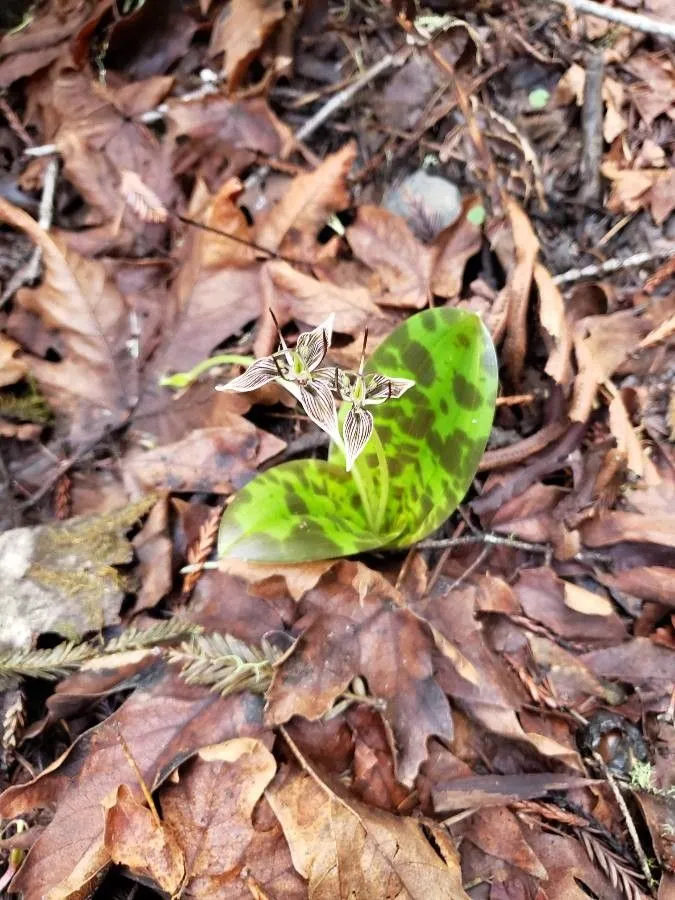
Author: Torr.
Bibliography: Pacif. Railr. Rep. Whipple, Bot. 4(5; 4): 145 (1857)
Year: 1857
Status: accepted
Rank: species
Genus: Scoliopus
Vegetable: False
Observations: NW. & CW. California
The Foetid adder’s-tongue, scientifically known as Scoliopus bigelovii, is an intriguing plant that belongs to the Liliaceae family. This unique species finds its home primarily in the northwestern and central western regions of California, where it thrives in the damp, shaded understory of coastal forests.
Scoliopus bigelovii was first described in the mid-19th century, with its classification detailed in the Pacific Railroad Report by Whipple, specifically in the botanical section authored by Torr. (1857). The plant’s distinct common name, Foetid adder’s-tongue, is derived from its curious and somewhat unpleasant odor, which is unmistakable upon closer inspection.
This species is notable for its unusual reproductive strategy. The flowers of the Foetid adder’s-tongue are small and somewhat inconspicuous, often blending into the forest floor. These flowers emit a fetid smell, which is particularly noticeable when the plant is in bloom. This odor plays a vital role in the plant’s pollination process, attracting specific pollinators such as fungus gnats, which are drawn to the scent and assist in the plant’s reproductive cycle.
The botanical characteristics of Scoliopus bigelovii include a basal arrangement of leaves that are speckled and somewhat resemble the tongue of an adder, giving rise to its common name. The leaves are typically large, green, and glossy with purple spots, and they grow close to the ground. The plant’s flowers have three sepals and three petals, which are similar in appearance, and are generally brownish-green to purple, further contributing to their understated presence.
Foetid adder’s-tongue is adapted to the specific environmental conditions of its native range. It prefers moist, well-drained soils rich in organic matter, which are commonly found in the lush, shaded environments of California’s coastal forests. These conditions support the plant’s growth and allow it to complete its life cycle, blooming from late winter to early spring.
In summary, the Foetid adder’s-tongue is a fascinating member of the Liliaceae family, characterized by its distinctive odor and adaptive strategies for survival and reproduction in the damp, shaded habitats of northwestern and central western California. Its remarkable botanical features and ecological niche make it a subject of interest for botanists and plant enthusiasts alike.
Eng: california fetid adderstongue, brownies, foetid adder’s-tongue, stinkpod
En: Foetid adder’s-tongue, Stinkpod, Brownies, California fetid adderstongue
© copyright of the Board of Trustees of the Royal Botanic Gardens, Kew.
© copyright of the Board of Trustees of the Royal Botanic Gardens, Kew.
Taken Feb 7, 2016 by EOL − Liam O’Brien (cc-by-nc)
Taken Feb 29, 2016 by EOL − Donna Pomeroy (cc-by-nc)
Taken Feb 10, 2016 by EOL − John Doyle (cc-by)
Taken Apr 1, 2016 by EOL − matzat (cc-by-nc)
Taken Apr 9, 2016 by EOL − elkman22 (cc-by-nc)
Taken Jan 20, 2016 by EOL − Alex Jones (cc-by-nc)
Taken Feb 14, 2016 by EOL − laceypantalones (cc-by-nc)
Taken Feb 14, 2016 by EOL − laceypantalones (cc-by-nc)
Taken Feb 14, 2016 by EOL − laceypantalones (cc-by-nc)
Taken Jan 30, 2021 by kate halsey (cc-by-sa)
Taken Mar 16, 2015 by EOL − Don Loarie (cc-by)
Taken Dec 1, 1998 by EOL − Charles Webber (cc-by-nc-sa)
Growth habit>: Forb/herb
Family: Myrtaceae Author: (F.Muell.) K.D.Hill & L.A.S.Johnson Bibliography: Telopea 6: 402 (1995) Year: 1995 Status:…
Family: Rubiaceae Author: Pierre ex A.Froehner Bibliography: Notizbl. Bot. Gart. Berlin-Dahlem 1: 237 (1897) Year:…
Family: Sapindaceae Author: Koidz. Bibliography: J. Coll. Sci. Imp. Univ. Tokyo 32(1): 38 (1911) Year:…
Family: Asteraceae Author: A.Gray Bibliography: Pacif. Railr. Rep.: 107 (1857) Year: 1857 Status: accepted Rank:…
Family: Fabaceae Author: Medik. Bibliography: Vorles. Churpfälz. Phys.-Ökon. Ges. 2: 398 (1787) Year: 1787 Status:…
Family: Aspleniaceae Author: (Cav.) Alston Bibliography: Bull. Misc. Inform. Kew 1932: 309 (1932) Year: 1932…